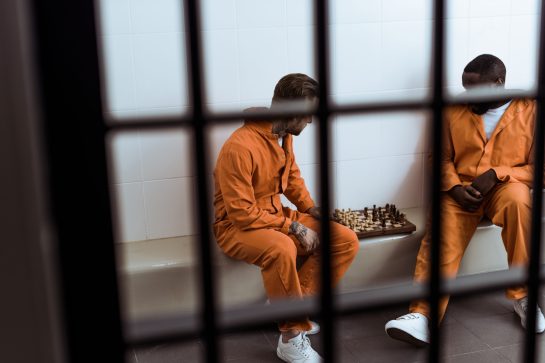COVID-19 has been spreading rapidly in the United States prison systems. The best way to reduce the close-quarter spread is to release as many inmates as possible.
COVID Spreading Throughout Prisons
In the United States we have seen rapid growth of COVID-19 within prisons since March of 2020, due to the high density of people confined in such small quarters. According to The Marshall Project1, new COVID–19 cases among prisoners reached an all-time high in early August, with 132,677 cases reported among US prisoners since the outbreak. COVID-19 cases in US federal and state prisons were estimated to be 5.5 times higher than the general public. The death rates were 3 times higher for inmates than the general public2.
Inmates are not the only people at risk—there is also the prison staff and general public to consider. Keeping the prisons at full capacity is putting the general public at risk because the staff goes in and out of the prisons daily. This increases the risk of spreading the illness outside of the prison to family members of the staff and the broader community.
Releasing Prisoners Early to Stop Spread
Voters within the United States have responded favorably to releasing inmates early to reduce the spread of COVID-193. The reduction of jail and prison populations can be achieved by releasing people within six months of their sentences, releasing prisoners with underlying health conditions, and sending fewer people into jail unnecessarily.
US leaders have not always been in favor of releasing prisoners early4. But COVID-19 being cultivated within prisons poses a higher risk to the public than releasing the inmates into monitored parole. Large scale releases have been a common pattern in U.S. history, and have not resulted in increased crime rates. It all depends on releasing prisoners responsibly and effectively.
To effectively combat virus spread among inmates, certain policies should be followed. Incoming prisoners must be screened and isolated accordingly before entering the prison5. Identifying cases rapidly to limit the spread should be a common protocol from now on. Authorities need to immediately release prisoners that don’t pose a risk to society or that have underlying health conditions that COVID-19 could make worse. The COVID-19 pandemic within prison systems needs to be sorted out before it results in mass amounts of prisoners being transferred to public hospitals and overwhelming the system. By preventing this additional strain on our already limited resources, protecting our communities, and saving lives, releasing prisoners early serves the public’s greater good.
Entry into Society in the Height of a Pandemic
Prisoner reentry poses a challenge under the best of circumstances, but especially during a pandemic. Job security is at an all-time low, health care systems are overwhelmed, and former inmates find themselves (once again) isolated from the outside world. To adjust to these challenges, organizations that help prisoners reenter society are now accomplishing this digitally6. In these unprecedented times former inmates are struggling to acquire housing, food, medical services, and jobs. Implementing case management technology into health and social services organizations has never been more vital in preventing people from falling through the cracks.
Implementing Community Care Coordination to Assist Former Inmates
To coordinate successful transitions and care for individuals leaving prison, states and localities need a comprehensive, case management platform for prisoner re-entry that can promote collaboration and data sharing across multiple care providers and databases, better enabling health and human services organizations to connect individuals to critical health and support services. The ClientTrack case management platform provides the tools needed to track and manage outcomes for parolees to prevent recidivism and improve their overall wellbeing. ClientTrack’s flexibility translates into a platform that can be scaled or pared to meet the needs of communities of any size and programs of any complexity.
Community care coordination is a vital tool in the success of any prisoner reentry process. When health and social services organizations can coordinate programs, share data, and communicate effectively, it allows them to identify and address the needs of each individual client. ClientTrack provides the tools necessary to power a holistic approach so that former offenders can have access to all of the resources that they need to rebuild their lives, lowering their risk of recidivism, and keeping communities safer from COVID-19 outbreaks.
SOURCES
- https://www.themarshallproject.org/2020/05/01/a-state-by-state-look-at-coronavirus-in-prisons
- https://www.cidrap.umn.edu/news-perspective/2020/07/us-prison-inmates-among-those-hit-hard-covid-19
- https://www.prisonpolicy.org/virus/
- https://www.prisonpolicy.org/blog/2020/04/09/large-scale-releases/
- https://www.washingtonpost.com/opinions/2020/03/17/we-must-release-prisoners-lessen-spread-coronavirus/
- https://www.usnews.com/news/healthiest-communities/articles/2020-04-15/prisoners-released-due-to-coronavirus-enter-a-different-world



